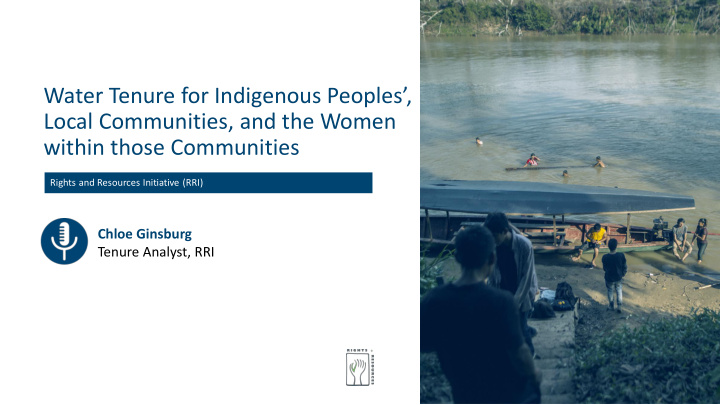



Water Tenure for Indigenous Peoples’, Local Communities, and the Women within those Communities Rights and Resources Initiative (RRI) Chloe Ginsburg Tenure Analyst, RRI
RRI Tenure Data: Tracking Indigenous Peoples’, local communities’ & women’s rights to lands, forests, & natural resources 2002 2012 2014 2018 2015 2017 Who Owns the What Rights? What Future For At a Crossroads Who Owns the Power and World’s Forests? Reform? World’s Land? Potential Informing and influencing advocacy, policy-decisions, research, investment approaches, and other stakeholder engagement concerning the land, forest, water, and other natural resource rights of Indigenous Peoples, local communities, and women within those communities.
Lessons Learned: Land and Forest Tenure • Efforts to advance the recognition of Indigenous Peoples’ and local communities’ rights have greatly benefited from two developments: 1. Endorsement and application a “land tenure” approach that conceptualizes the bundle of land and forest tenure rights held by Indigenous Peoples and local communities either legally or in practice, and 2. Wide acceptance of secure community land tenure rights as a prerequisite for sustainable land governance and the broad realization of sustainable development and climate goals. • These have strengthened the position of IPs and local communities within the political economy of land and forest governance and had tangible positive results.
Relationships between Indigenous Peoples and local communities and their freshwater • Community-based water tenure systems are complex, cross- sectoral, dynamic, and context-specific. • Customary or traditional water tenure systems and/or practices may or may not be recognized by statutory law. • Community waters are under escalating pressure worldwide due to climate, development, and demographic pressures — which in turn exacerbate threats of displacement, violence, and conflict. • The realization of communities’ freshwater tenure rights is directly linked to their ability to realize basic human needs, maintain food security and sustainable livelihoods, and to achieve other essential objectives.
Indigenous and community women’s particular relationship with freshwater • Women have differentiated knowledge about water accessibility, quality, and usage patterns that is vital to sustainable resource management, health and food security. • Woman also have differing responsibilities, priorities, and needs for domestic AND productive uses of water. • Main unpaid suppliers of water around the world • Primarily responsible for using and making decisions about water to meet daily household needs (WHO and UNICEF, 2017) • Produce 60-80% of food and constitute 43% of on-farm labor force in developing countries (IFPRI 2019) • Unique hygiene and sanitation needs • And yet, evidence has revealed a clear gap between women’s roles and their recognized rights. Water Alternatives / Flickr
Indigenous Peoples’ and local communities’ water tenure is largely overlooked • Indigenous Peoples, local communities, and indigenous and community women are often unaware of — and unable to effectively assert — the bundle of rights necessary to ensure their water security or their water tenure. • Legally recognized rights comprising communities’ secure freshwater tenure have yet to be conceptualized, widely accepted, analysed, or tracked over time.
An innovative comparative analysis on community-based water tenure Community-Based Water Tenure Regime (CWTR): A distinguishable set of national laws and regulations governing all situations in which freshwater rights of use and at least either governance or exclusion are held at the community level . National-Level Indicators Additional Information Threshold Questions • • • Human Right? Use (cultural/religious, domestic, Duration • • Transboundary Due livelihoods, commercial) Prioritization/Hierarchy • • Process? Transferability Land-Water Nexus • • Exclusion Procedural CWTR-Level • Governance (rulemaking, planning and Requirements Threshold Questions management, internal dispute resolution, • Customary Rights? external enforcement) • Dependent on Land • Domestic Due Process and Compensation Rights? • Women’s Rights?
Land-Water Nexus Key Finding • Communities’ legal rights to freshwater are dependent on their recognized land or forest rights in over 60% (25) of 39 CWTRs . Implication • These 25 CWTRs establish consistently more adequate protections for communities’ freshwater rights—including women’s rights to use or govern community waters. • Legislative “land - water nexus” serves as communities’ only source of recognized water entitlements under the national laws of Cambodia, India, Liberia, and Mexico. • Legislative harmonization and inter-sectoral collaboration are critical, with “community - based water tenure” as a conceptual foundation.
Women’s Specific Rights to Use and Govern Community Waters Key Finding • Laws regulating community-based freshwater rights are typically gender-blind, with just one-third (13) of 39 CWTRs protecting women’s specific rights to participate in freshwater governance: • 8 CWTRs protect women’s rights to participate in community - based decision-making processes pertaining to community lands that include rights to govern freshwater, and • 5 CWTRs explicitly recognize indigenous and community women’s rights to govern water resources . Implication • Explicitly acknowledge the freshwater rights of women within indigenous and local communities during legislative reforms. • Raise communities’ awareness of land -water nexus as basis for existing, gender-specific rights.
Implications for the future of water tenure • Land laws frequently address water only implicitly or in passing as appurtenant to a wider set of communities’ territorial rights, whereas water laws often fail to address interactions with community land rights. • Harmonization across water, forest, and land legislation is particularly important where legal frameworks do not exclusively tether community water rights to community land rights. • Legislative and policy reforms must take a tenure-based approach to recognizing the full bundle of community-based water tenure rights and promote an integrated approach to community-based resource tenure if they are to protect Indigenous Peoples’ and local communities’ rights.
Recommend
More recommend